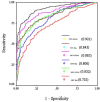Prediction of GTP interacting residues, dipeptides and tripeptides in a protein from its evolutionary information
- PMID: 20525281
- PMCID: PMC3098072
- DOI: 10.1186/1471-2105-11-301
Prediction of GTP interacting residues, dipeptides and tripeptides in a protein from its evolutionary information
Abstract
Background: Guanosine triphosphate (GTP)-binding proteins play an important role in regulation of G-protein. Thus prediction of GTP interacting residues in a protein is one of the major challenges in the field of the computational biology. In this study, an attempt has been made to develop a computational method for predicting GTP interacting residues in a protein with high accuracy (Acc), precision (Prec) and recall (Rc).
Result: All the models developed in this study have been trained and tested on a non-redundant (40% similarity) dataset using five-fold cross-validation. Firstly, we have developed neural network based models using single sequence and PSSM profile and achieved maximum Matthews Correlation Coefficient (MCC) 0.24 (Acc 61.30%) and 0.39 (Acc 68.88%) respectively. Secondly, we have developed a support vector machine (SVM) based models using single sequence and PSSM profile and achieved maximum MCC 0.37 (Prec 0.73, Rc 0.57, Acc 67.98%) and 0.55 (Prec 0.80, Rc 0.73, Acc 77.17%) respectively. In this work, we have introduced a new concept of predicting GTP interacting dipeptide (two consecutive GTP interacting residues) and tripeptide (three consecutive GTP interacting residues) for the first time. We have developed SVM based model for predicting GTP interacting dipeptides using PSSM profile and achieved MCC 0.64 with precision 0.87, recall 0.74 and accuracy 81.37%. Similarly, SVM based model have been developed for predicting GTP interacting tripeptides using PSSM profile and achieved MCC 0.70 with precision 0.93, recall 0.73 and accuracy 83.98%.
Conclusion: These results show that PSSM based method performs better than single sequence based method. The prediction models based on dipeptides or tripeptides are more accurate than the traditional model based on single residue. A web server "GTPBinder" http://www.imtech.res.in/raghava/gtpbinder/ based on above models has been developed for predicting GTP interacting residues in a protein.
Figures



References
Publication types
MeSH terms
Substances
LinkOut - more resources
Full Text Sources

